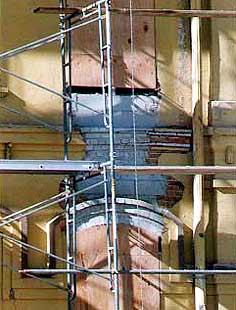
 |
||||||




Do you ever hear someone say they're "restoring" a building when they're really rehabilitating or preserving it? It would seem to be a simple difference in labeling, but it's really an important distinction in historic preservation. Why? As seen in Chrisfield, following each approach achieves a very different end "product." To help get it right, here are some suggestions:
1. Become familiar with the four approaches to work—or treatment—and how and why they differ.
In theSecretary of the Interior's Standards for the Treatment of Historic Properties , the National Park Service identifies four approaches to work and provides four separate sets of principles or standards as guides. These brief descriptions characterize the major differences between approaches:
Preservation keeps a building and its site the way it looked historically, with all the respectful changes and alterations that were made to it over time.
Rehabilitation updates a building and its site through alterations and additions while preserving its historic character.
Restoration creates the appearance of a building and its site as it existed during its period of greatest significance while removing evidence of other periods.
Reconstruction re-creates a non-surviving site, landscape, building, structure, or object in new materials for interpretive purposes.
2. Become familiar with some general questions you need
to ask—and
answer—as background for choosing a work approach.
First, what is the relative historical significance of the building in the community? Is the building an individual local landmark? Or is it a commercial or residential building that contributes to the significance of the historic district? Rehabilitation is more commonly applied to commercial and residential buildings in historic districts. Preservation, Restoration, and Reconstruction are more often selected for local landmarks that are being interpreted to the public. Reconstruction is rarely recommended.
What is the current condition of historic materials
and features?
If the distinctive materials and features of the building need
minor repairs, very limited replacement, or stabilization and no alterations
or additions are planned, then Preservation should be considered as a
work approach. But, if the building's distinctive features are extensively
deteriorated or missing and need to be replaced-or if alterations or additions
to the building and site are part of the work, consider Rehabilitation.
If sufficient original materials exist and the goal is to systematically
re-create the appearance of the building as it appeared during its period
of greatest significance by removing all materials that are outside the
period, then consider Restoration.
Very important, what is the proposed use of
the historic building?
Do you plan to update, add to, or alter the building for a new
commercial use or ongoing residential use? Do you plan to preserve it,
as is, and interpret its history to the public? Do you plan to restore
it to an earlier appearance and interpret its history to the public? You
want to fit the new use to the building. If not, you will destroy valuable
historic materials in the process.
What are the mandated code requirements?
This is always an essential consideration that can affect materials
and features. They may include seismic upgrading, lead paint or asbestos
abatement, and ADA requirements—accessibility to individuals with
disabilities.
---------------------------------